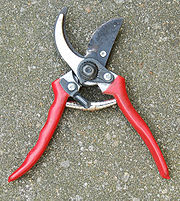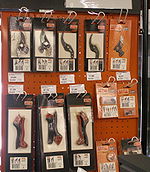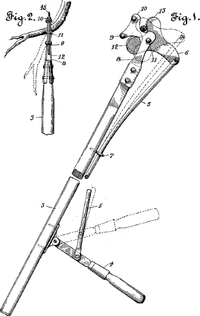
Pruning shears
Encyclopedia

Scissors
Scissors are hand-operated cutting instruments. They consist of a pair of metal blades pivoted so that the sharpened edges slide against each other when the handles opposite to the pivot are closed. Scissors are used for cutting various thin materials, such as paper, cardboard, metal foil, thin...
for use with plants. They are strong enough to prune
Pruning
Pruning is a horticultural practice involving the selective removal of parts of a plant, such as branches, buds, or roots. Reasons to prune plants include deadwood removal, shaping , improving or maintaining health, reducing risk from falling branches, preparing nursery specimens for...
hard branches of trees and shrubs, sometimes up to two centimetres thick. They are used in gardening
Gardening
Gardening is the practice of growing and cultivating plants. Ornamental plants are normally grown for their flowers, foliage, or overall appearance; useful plants are grown for consumption , for their dyes, or for medicinal or cosmetic use...
, arboriculture
Arboriculture
Arboriculture is the cultivation, management, and study of individual trees, shrubs, vines, and other perennial woody plants. It is both a practice and a science....
, farming, flower arranging, and nature conservation where fine-scale habitat management is required.
Loppers
Loppers
Loppers are a type of scissors used for pruning twigs and small branches. They are the largest type of manual garden cutting tool. They are usually operated with two hands, and with handles around 65 cm long to give good leverage...
are a larger, two-handed, long-handled version for branches thicker than pruning shears can cut.
Designs

Handle length

Handle (grip)
A handle is a part of, or attachment to, an object that can be moved or used by hand. The design of each type of handle involves substantial ergonomic issues, even where these are dealt with intuitively or by following tradition...
s and are operated with one hand. A spring
Spring (device)
A spring is an elastic object used to store mechanical energy. Springs are usually made out of spring steel. Small springs can be wound from pre-hardened stock, while larger ones are made from annealed steel and hardened after fabrication...
between the handles causes the jaws to open again after closing. When not in use, the jaws may be held closed by a safety catch or by a loop holding the handles together. Some may be designed for right-handed or left-handed use only and some may incorporate a rotating handle to reduce friction
Friction
Friction is the force resisting the relative motion of solid surfaces, fluid layers, and/or material elements sliding against each other. There are several types of friction:...
and minimize hand stress during repetitive use. There are also longer versions called telescopic pruners which are adjustable for long-reach and operate by means of a rod system inside of a telescoping pole between the handles and the blades. An early version of these was known as an averruncator
Averruncator
An averruncator is a form of long shears used in arboriculture for averruncating or pruning off the higher branches of trees, etc. The word averruncate glided into meaning to weed the ground, prune vines, etc., by a supposed derivation from the Lat...
.

